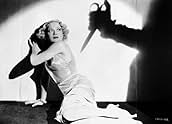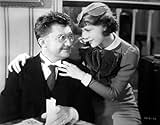A doctor who is also a "mentalist" confesses to a murder. The only problem is that the murder he's confessed to hasn't happened yet--although dead bodies are now starting to turn up all over... Read allA doctor who is also a "mentalist" confesses to a murder. The only problem is that the murder he's confessed to hasn't happened yet--although dead bodies are now starting to turn up all over the place. A reporter sets out to solve the "mystery".A doctor who is also a "mentalist" confesses to a murder. The only problem is that the murder he's confessed to hasn't happened yet--although dead bodies are now starting to turn up all over the place. A reporter sets out to solve the "mystery".
- Director
- Writers
- Stars
- Awards
- 1 win total
- Detective
- (uncredited)
- Bridge Player
- (uncredited)
- Police Recorder
- (uncredited)
- Announcer
- (uncredited)
- Bridge Player
- (uncredited)
- Hungry Police Guard
- (uncredited)
- Police Desk Sergeant
- (uncredited)
- Director
- Writers
- All cast & crew
- Production, box office & more at IMDbPro
Featured reviews
Which, the cops inform him, isn't a crime until he does it. He goes with one of them to his home, where the patient is waiting..... and the corpses start to pile up.
It's a heck of a set-up, and a pretty good mystery in this definitely pre-code movie, in which reporter Stu Erwin falls in love instantly with Frances Dee, Hersholt's daughter and tries to solve the murder himself. With Torben Meyer, William Janney, Samuel S. Hinds as the patient and Fred Kelsey as a dumb cop.
The 1933 Crime of the Century, directed by William Beaudine, stars Jean Hersholt as Dr. Emil Brandt, a hypnotist who works with people from all walks of life.
Brandt enters the police station begging to be arrested for murder. However, he hasn't committed it yet. His patient, Philip Ames (Samuel S. Hinds) works in a bank. Under hypnosis, he has commanded Ames to bring him $100,000 - and then he plans to murder him.
The Captain, Riley (Robert Elliott) and a detective Martin (David Landau) agree to keep him from killing Ames. Martin will go with him first, and Elliott will replace him when he goes off duty.
When they arrive at the branch home, Brandt's daughter Doris (Frances Dee) arrives home. Martin then is able to leave.
It turns out that Brandt's wife, Doris' stepmother (Wynne Gibson) is somewhat money hungry, and has spent a great deal of Brandt's money. She arrives home to get ready to go to the theater. We find out that she knows about the $100,000 and in fact, she has her boyfriend Gilbert (Gordon Westcott) outside ready to step in and steal the money.
Ames arrives, as does Captain Elliott. Brandt gets the money, replaces it in Ames' pocket with Elliott as witness and programs Ames to return the money.
The lights go out. There's a struggle. Ames is dead and the money is gone. With many suspects. A reporter (Stu Erwin) stops by and tries to put it together.
Later, during a re-enactment, there is another murder.
The film is interrupted toward the end and a man appears, giving the audience one minute to see if they can solve the murder.
One fun thing: a suspect is asked to try on a glove. Shades of OJ.
At 1:11, the film seemed long to me, but it was a good mystery with fine performances and fun re-enactments.
Enjoyable.
The murderer is hard to guess, and this also has some interesting genre features. One is that the main suspect turns himself in before the crime. What mars this is that we have that one anti-cinematic device: the lights go out and events happen without us being able to see them. All crimes happen on-screen, but the crime itself is occluded. This happens twice, each time there is a murder.
As a narrative device, we have evolved away from this one, and I guess I am sad to see it go, because with it, you have purity: everything essential happens in front of you. But evolved away we have, to be replaced by off screen unknowns.
We have also lost the character who is our on-screen detective, but not as a result of cinematic development. These guys just faded from life in general, the newspaper crime reporter. That is a loss too.
The movie began with Dr. Emil Brandt (Jean Hersholt) pleading to detectives Riley (Robert Elliott) and Martin (David Landau) to lock him up. Why? Because he planned to commit murder for money. If the cops locked him up then he couldn't commit the murder.
He had hypnotized a man by the name of Philip Ames (Samuel S. Hinds) and commanded him to steal $100,000 and bring it back to him by 8:15 p.m. He was then going to kill Philip and take the $100,000 for himself. The killing part is why he wanted to be locked up. He couldn't trust himself not to kill Philip, but police don't make arrests for crimes that haven't happened.
It turns out that Dr. Brandt needed the money to appease his wife, Freda (Wynne Gibson). She was a gold digger and was going to double cross Dr. Brandt and run off with the money with her lover, Gilbert Reid (Gordon Westcott). She never got that chance because a fourth person (someone besides Freda, Gilbert, or Dr. Brandt) entered the house, killed Philip, and took the money. The main suspects were the three aforementioned with an outside chance of it being one of the detectives, or the newspaperman, Dan McKee (Stuart Erwin), or the help, or another man who was anonymous.
There was enough intrigue with the murder and the cast of characters that I stayed tuned in. $100,000 is enough for just about anyone to commit murder, so everybody was in play. There was very little focus on characters with the exception of establishing who they were and a small glimpse of what type of person they were, and that allowed the movie to stay focused on the murder and solving the murder. That's what I want from a murder mystery. I don't need to know a whole lot about each character except what's germane to the plot. "The Crime of the Century" kept everything crime-centric even if it wasn't "the crime of the century."
Free on YouTube.
Did you know
- TriviaToward the end of the film, the story is interrupted by the appearance of an announcer (played by Arthur Hohl) who states that mysteries move too swiftly for the audience to determine the villain, and for this reason a one minute intermission will be provided for them to solve the mystery on their own before returning to the story.
- Quotes
Announcer: [the movie pauses and the announcer makes the following statement after which a clock appears on the screen and the numbers 1 to 60 are superimposed on the faces of the suspects] Ladies and gentlemen, the great trouble with murder stories on the screen is that the audience has no time to solve the mystery. When reading a book, it is possible to put it down at any time to think; in a play, there are intervals between the acts. But a film moves so fast that the audience doesn't have a chance to play detective. Sitting there in your seats, you have witnessed two murders. You have seen exactly how they were done and who were present. All the clues known to the police are known to you. We are trying a little experiment: we are going to give you one minute by that clock, in which to guess who murdered Philip Ames and Mrs Brandt.
Details
- Runtime
- 1h 13m(73 min)
- Color
- Aspect ratio
- 1.37 : 1
































